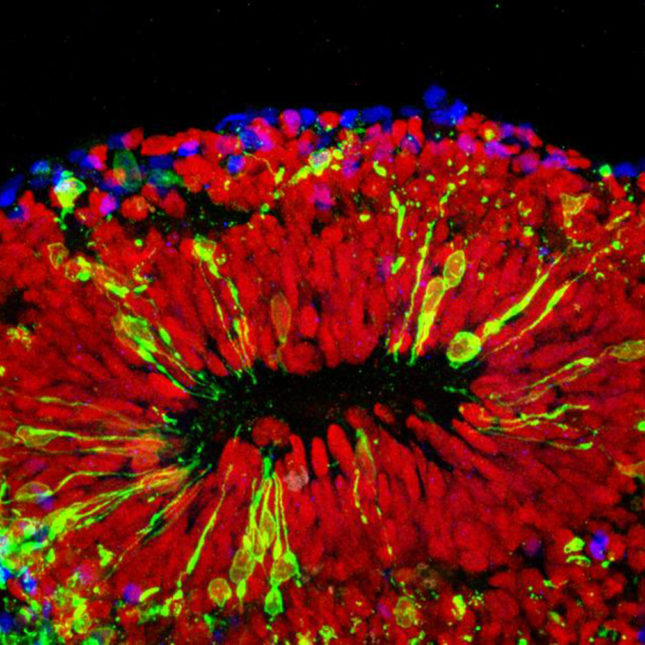
Minuscule blobs of human brain tissue have come a long way in the four years since scientists in Vienna discovered how to create them from stem cells.
The most advanced of these human brain organoids — no bigger than a lentil and, until now, existing only in test tubes — pulse with the kind of electrical activity that animates actual brains. They give birth to new neurons, much like full-blown brains. And they develop the six layers of the human cortex, the region responsible for thought, speech, judgment, and other advanced cognitive functions.
These micro quasi-brains are revolutionizing research on human brain development and diseases from Alzheimer’s to Zika, but the headlong rush to grow the most realistic, most highly developed brain organoids has thrown researchers into uncharted ethical waters. Like virtually all experts in the field, neuroscientist Hongjun Song of the University of Pennsylvania doesn’t “believe an organoid in a dish can think,” he said, “but it’s an issue we need to discuss.”
Those discussions will become more urgent after this weekend. At a neuroscience meeting, two teams of researchers will report implanting human brain organoids into the brains of lab rats and mice, raising the prospect that the organized, functional human tissue could develop further within a rodent. Separately, another lab has confirmed to STAT that it has connected human brain organoids to blood vessels, the first step toward giving them a blood supply.
That is necessary if the organoids are to grow bigger, probably the only way they can mimic fully grown brains and show how disorders such as autism, epilepsy, and schizophrenia unfold. But “vascularization” of cerebral organoids also raises such troubling ethical concerns that, previously, the lab paused its efforts to even try it.
“We are entering totally new ground here,” said Christof Koch, president of the Allen Institute for Brain Science in Seattle. “The science is advancing so rapidly, the ethics can’t keep up.”
Neither can regulation: Although the National Institutes of Health has a moratorium on funding research that puts human stem cells into the early embryos of vertebrates, there is no such ban on implanting human organoids, and virtually no one outside the labs conducting organoid research has enough of an idea about what’s going on to, say, call for a commission to study what should and should not be allowed.
In the previously unreported experiments implanting human brain organoids into lab rodents, most of the transplants survived, in one case for at least two months, according to summaries of the two papers being presented at the annual meeting of the Society for Neuroscience in Washington, D.C. More notably, the human organoids implanted into mice connected to the rodent’s circulatory system, making this the first reported vascularization. And mature neurons from the human brain organoid sent axons, the wires that carry electrical signals from one neuron to another, into “multiple regions of the host mouse brain,” according to a team led by Fred “Rusty” Gage of the Salk Institute, one of the world’s most eminent neurobiologists.

A human brain organoid cannot reach anything close to the size of even a child’s brain in the tiny confines of a mouse’s (which is one one-thousandth the volume of a person’s brain), almost certainly limiting how complex it can become. “These little suckers are not going to say ‘Hi,’” said legal scholar and bioethicist Hank Greely of Stanford University. But the rapid advances, he said, are raising the question “of whether you are creating something human-ish that you have to take seriously in terms of according it dignity and respect — and figuring out what that even means.”
Those issues emerged 17 years ago, when a Stanford colleague of Greely’s proposed implanting human stem cells into mouse brains to see what would happen when the former turned into neurons; the experiment has not yet happened. But the ethical consensus was that it might be OK if the fraction of human neurons in the mouse brain was so small that the implant had no chance of giving the mouse human consciousness or enhanced intelligence.
The summary of his experiment that Gage sent to the neuroscience meeting did not specify the size of the human brain organoids he and his colleagues implanted into mice; he told STAT that he could not talk about the work because he had submitted it to a journal. Nor did the summary indicate whether the Salk team tested for changes in the mice’s abilities or behavior. If the human organoid caused such changes, it would raise profound ethical concerns, said bioethicist Josephine Johnston of The Hastings Center.
“It brings up some pretty interesting questions about what allows us, ethically, to do research on mice in the first place — namely, that they’re not human,” she said. “If we give them human cerebral organoids, what does that do to their intelligence, their level of consciousness, even their species identity?”
In another study scheduled to be presented at the neuroscience meeting — 21 brain organoid papers are on tap — researchers led by Dr. Isaac Chen, a neurosurgeon at the University of Pennsylvania, implanted human cerebral organoids into the brains of 11 adult rats, specifically the secondary visual cortex. That structure processes visual signals to, for instance, figure out the color and orientation of something the eye has seen.
The 2-millimeter organoids survived for at least two months, Chen said in an interview, and showed “extensive” growth of human axons into the rat brain. Some of the axons grew as much as 1.5 millimeters, connecting to the corpus callosum, a bundle of neurons connecting the left and right cerebral hemispheres. When the scientists shined light on a rat’s eye, or stimulated brain regions involved in vision, neurons in the implanted organoid fired. That suggested the human brain tissue had become functionally integrated with the rat’s.
Chen’s hope is that organoids might one day be used to treat brain injury, stroke, and even schizophrenia and autism. Scientists have long hoped to do that for Parkinson’s disease, using injections of neurons — essentially, cell slurry.
“My interest is in repairing the brain,” Chen said, and he suspects that implanting tissue that is already organized, structured, and displaying electrical activity — a brain organoid — might work better. “The brain is a very, very ordered structure,” he said. “So an implant with existing structure and intrinsic circuitry might integrate” with the damaged brain more effectively and fix it.
He and his colleagues discussed the ethics of implanting human brain organoids into rats, including whether the animals might become too human. “Some of what people warn about is still science fiction,” he said. “Right now, the organoids are so crude we probably decrease” the rats’ brain function.
Ethicists argue that “not a problem now” doesn’t mean “never a problem.” One concern raised by the human brain organoid implants “is that functional integration [of the organoids] into the central nervous system of animals can in principle alter an animal’s behavior or needs,” said bioethicist Jonathan Kimmelman of McGill University in Montreal. “The task, then, is to carefully monitor if such alterations occur.” If the human implant gives an animal “increased sentience or mental capacities,” he added, it might suffer more.
Would it feel like a human trapped in a rodent’s body? Because both the Salk and Penn experiments used adult rodents, their brains were no longer developing, unlike the case if implants had been done with fetal rodent brains. “It’s hard to imagine how human-like cognitive capacities, like consciousness, could emerge under such circumstances,” Kimmelman said, referring to implants into an adult rodent brain. Chen agreed: He said his experiment “carries much less risk of creating animals with greater ‘brain power’ than normal” because the human organoid goes into “a specific region of already developed brain.”
The belief that consciousness is off the table is in fact the subject of debate. An organoid would need to be much more advanced than today’s to experience consciousness, said the Allen Institute’s Koch, including having dense neural connections, distinct layers, and other neuro-architecture. But if those and other advances occur, he said, “then the question is very germane: Does this piece of cortex feel something?” Asked whether brain organoids can achieve consciousness without sensory organs and other means of perceiving the world, Koch said it would experience something different than what people and other animals do: “It raises the question, what is it conscious of?”
Many scientists working with cerebral organoids believe that the structures will forever be limited in complexity because they are not connected to the outside world. “This is not a brain growing in a dish,” said Penn’s Song. “We are who we are because we have experiences, and brain organoids do not have sensory inputs.”
Due to the competition and even secrecy surrounding brain organoid research, several leaders in the field did not know what others had accomplished until STAT described it. Contrary to Song’s assumption, for instance, another leading scientist has reportedly connected brain organoids in a dish to retinal cells, which perceive light and therefore produce vision.
“It’s hard to know the significance of that,” said one scholar with whom the scientist discussed the retina work. “What experience is the organoid having, and how would we ever figure that out?”
Another step that promises to produce larger, and more brain-like, organoids is to fuse several together. In May, scientists led by Jürgen Knoblich of Vienna’s Institute of Molecular Biotechnology, who led the original research that created 3-D brain organoids, reported fusing one organoid mimicking the top of the human forebrain with one mimicking the bottom, and got connecting neurons to wend their way from one to the other — a big step toward “model[ing] complex interactions between different brain regions,” he and his colleagues reported.
Even when brain organoids “connect like Legos,” Song said, “we still have the problem of size”: without a blood supply, the structures cannot grow large enough to mimic a fully-developed brain.
But that barrier, too, is likely to fall. In September, George Church of Harvard Medical School — it was he who delayed trying to give brain organoids a blood supply — told a small meeting at MIT that his lab had vascularized brain organoids. In contrast to the Salk and Penn experiments, which accomplished that via transplant into rodent brains, Church’s organoids are growing in lab dishes. He and his colleagues grew the vasculature with blood-vessel-making (endothelial) cells. “We can generate cerebral organoids with integrated endothelial tissue, this tissue forms tubes, and we can induce these tubes to sprout” into the nutrient broth that the cerebral organoids grow in, said John Aach, a geneticist in Church’s lab.
“The next step is to get fluids to flow through these tubes,” delivering oxygen and nutrients deep into the organoids and connecting the tubes to a heart-like pump, Aach said. Otherwise “you can’t grow them very large and you will be hampered in trying to get the organoid to develop more mature cell types and structures.” Church’s lab has “been getting closer to that goal,” he said, “but we haven’t yet clinched it.”
That could well be only a matter of time. Blood flow would make arrays of brain organoids more likely to survive, grow, and develop. “People are talking about connecting three or four,” said Stanford’s Greely. “But what if you could connect 1,000? That would be getting close to the number of cells in a mouse brain,” raising the distant prospect of a human brain organoid with cognitive and even emotional capacities, all while sitting in a lab dish.
“At some future point,” Greely said, “it could be that what you’ve built is entitled to some kind of respect.” Next year is the 200th anniversary of the publication of Mary Shelley’s “Frankenstein,” he noted: “I think that story is relevant to what we’re talking about.”
To submit a correction request, please visit our Contact Us page.












